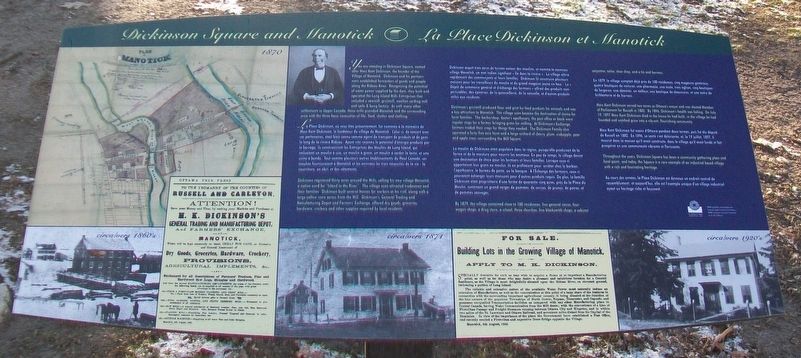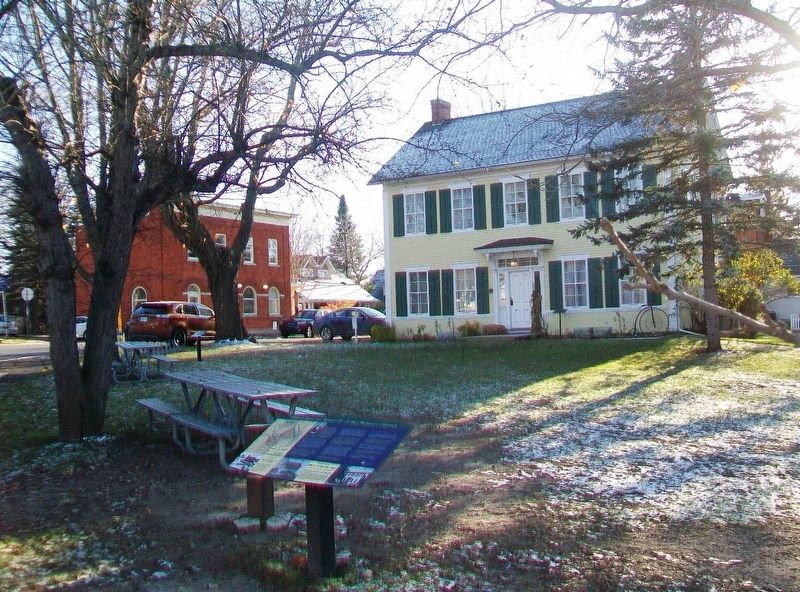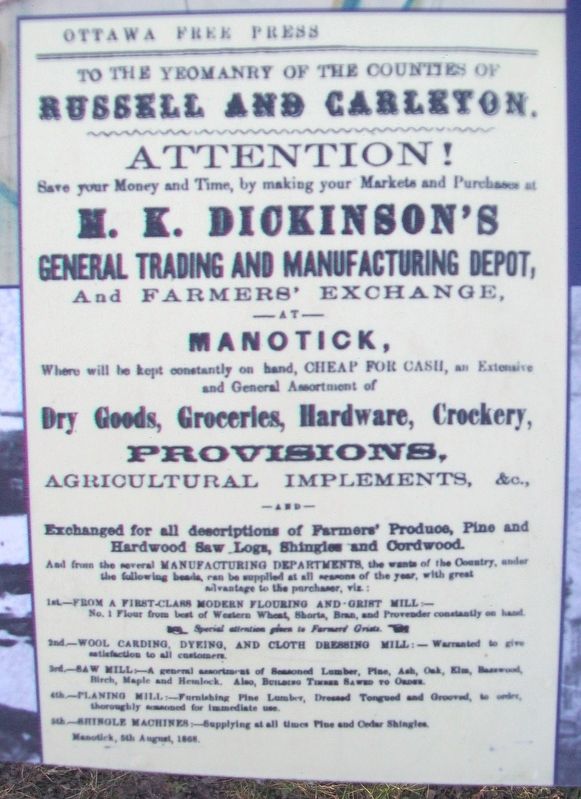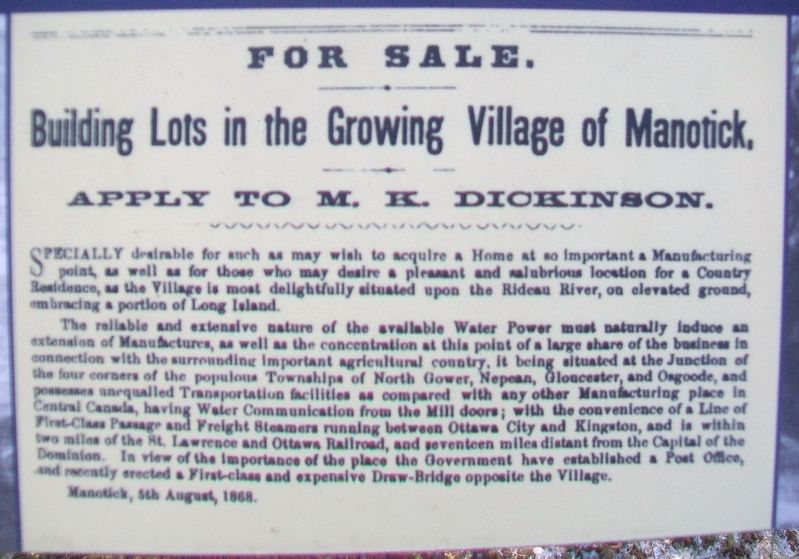Dickinson Square and Manotick / La Place Dickinson et Manotick
You are standing in Dickinson Square, named after Moss Kent Dickinson, the founder of the Village of Manotick. Dickinson and his partners were established forwarders of goods and people along the Rideau River. Recognizing the potential of water power supplied by the dam, they built and operated the Long Island Mills Enterprises that included a sawmill, gristmill, woollen carding mill and spile & bung factory. As with many other settlements in Upper Canada, these mills provided Manotick and the surrounding area with the three basic necessities of life: food, shelter and clothing.
Dickinson registered thirty acres around the Mills, calling his new village Manotick, a native word for "Island in the River". The village soon attracted tradesmen and their families. Dickinson built several houses for workers at his mill, along with a large yellow store across from the Mill. Dickinson's, General Trading and Manufacturing Depot and Farmers' Exchange, offered dry goods, groceries, hardware, crockery and other supplies required by local residents.
Dickinson's gristmill produced flour and grist for feed products for animals and
was a key attraction to Manotick. The village soon became the destination of choice for farm families. The barbershop, doctor's apothecary, the post office or bank were regular stops for a farmer bringing grain for milling. At Dickinson's Exchange, farmers traded their crops for things they needed. The Dickinson Family also operated a forty-five acre farm and a large orchard of cherry, plum, crabapple, pear and apple trees surrounding the Mill Square.By 1879, the village contained close to 100 residences, five general stores, four wagon shops, a drug store, a school, three churches, five blacksmith shops, a cabinet carpenter, tailor, shoe shop, and a tine and harness.
Moss Kent Dickinson served two terms as Ottawa's mayor and was elected Member of Parliament for Russell in 1882. By 1896, Dickinson's health was failing. On July 19, 1897 Moss Kent Dickinson died in the house he had built; in the village he had founded and watched grow into a vibrant, flourishing community.
Throughout the years, Dickinson Square has been a community gathering place and focal point; and today, the Square is a rare example of an industrial based village with a rich and fascinating heritage.
Dickinson acquit trois acres de terrain autour des moulins, et nomma le nouveau village Manotick, un mot indien signifiant « Île dans la rivière ». Le village attira rapidement des commerçants et leurs familles. Dickinson fit construire plusieurs maisons pour les travailleurs du moulin et du grand magasin jaune en face. Le « Dépôt de commerce général et d'échange des fermiers » offrait des produits non-périssables, des épiceries, de la quincaillerie, de la vaisselle, et d'autres produits utiles aux résidents.
La moulin de Dickinson était populaire dans la région, puisqu'elle produisait de la farine et de la mouture pour nourrir les animaux. En peu de temps, le village devint une destination de choix pour les fermiers et leurs
En 1879, le village comptait déjà près de 100 résidences, cinq magasins généraux, quatre boutiques de voitures, une pharmacie, une école, trois églises, cinq boutiques de forgeron, une ébéniste, un tailleur, une boutique de chaussures, et une autre de ferblanterie et de harnais.
Moss Kent Dickinson fut maire d'Ottawa pendant deux termes, puis fut élu député de Russell en 1882. En 1896, sa santé s'est détériorée, et, le 19 juillet, 1897, il mourut dans la maison qu'il avait construite, dans le village qu'il avait fondé et fait prospérer en une communauté vibrante et florissante.
Au cours des années, la Place Dickinson est devenue un endroit central de rassemblement; et aujourd'hui, elle est l'exemple unique d'un village industriel ayant un héritage riche et fascinant.
———————————————————
Erected by Watson's Mill Manotick, Inc. and City of Ottawa.
Topics. This historical marker is listed
Location. 45° 13.608′ N, 75° 40.996′ W. Marker is in Ottawa, Ontario. It is in Manotick. Marker is on Dickinson Street just east of Mill Street, on the left when traveling north. Touch for map. Marker is at or near this postal address: 1127 Mill Street, Ottawa ON K4M 1B1, Canada. Touch for directions.
Other nearby markers. At least 8 other markers are within walking distance of this marker. Family Life / la vie familiale (a few steps from this marker); Dickinson House / Maison Dickinson (a few steps from this marker); A Square for All Time / Un place en permanence (within shouting distance of this marker); The Long Island Mill (within shouting distance of this marker); Carriage Shed / Hangar à chariots (within shouting distance of this marker); The Mill and Manotick / Le moulin et Manotick (within shouting distance of this marker); A Safety Valve and Power Source (within shouting distance of this marker); War Memorial Cenotaph (within shouting distance of this marker). Touch for a list and map of all markers in Ottawa.
Also see . . .
Dickinson Square. The Manotick Directory website entry (Submitted on January 6, 2018, by William Fischer, Jr. of Scranton, Pennsylvania.)
Credits. This page was last revised on March 11, 2023. It was originally submitted on January 6, 2018, by William Fischer, Jr. of Scranton, Pennsylvania. This page has been viewed 447 times since then and 5 times this year. Photos: 1, 2, 3, 4. submitted on January 6, 2018, by William Fischer, Jr. of Scranton, Pennsylvania.



